Calathea Makoyana Peacock plant has gorgeous dramatic foliage with ruffled leaves. It grows in an upright bushy form to about 24 inches tall. Calathea Makoyana care is not difficult but needs to be correct.
With proper care the Calathea Makayana will grow large impressive leaves and create a wonderful, easy care, living focal point in your home.
But be aware. Calatheas do not forgive easily. This is not a set it and forget it plant.
Learn how to properly take care of this beautiful calathea plant. It will reward you for many years to come.
With a few inexpensive tools you can have a happy Peacock plant. Watch its amazing glossy foliage shine and glow for you.
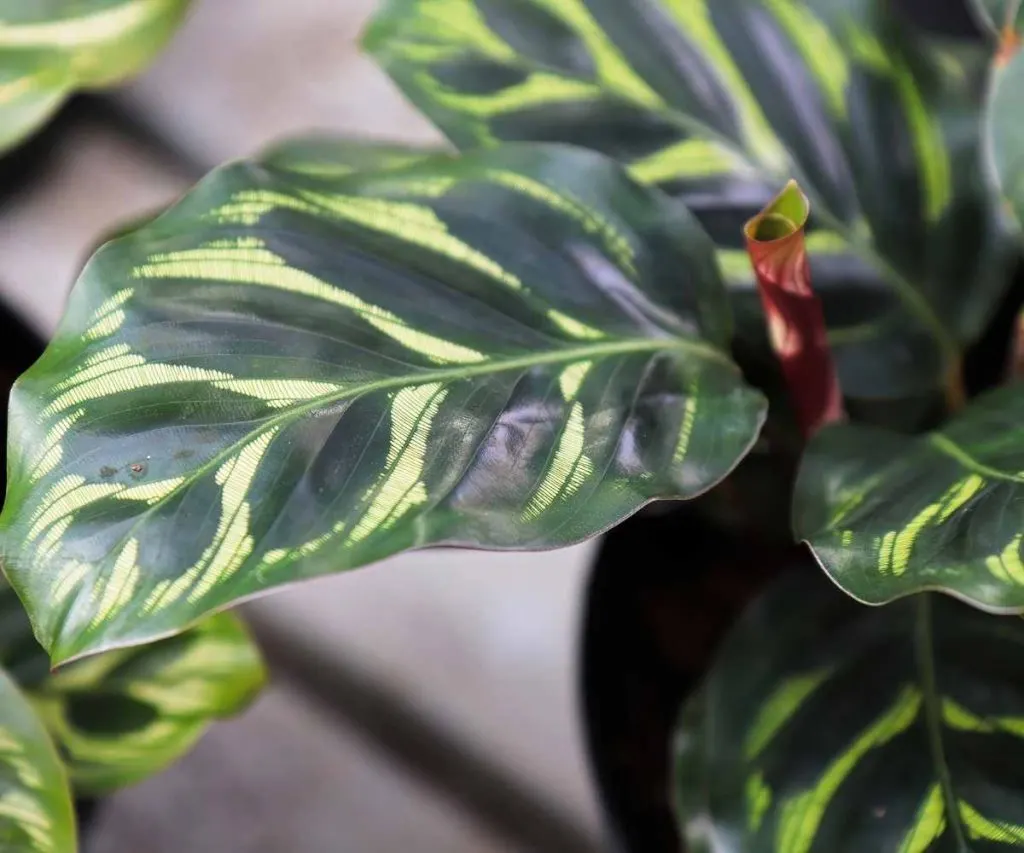
Peacock Plant Profile:
The Peacock plant genus is recently reclassified to Goeppertia makoyana. Like many of our other favorite Calathea Houseplants, the Peacock is actually not a Calathea anymore.
However, you will find these plants most often in garden shops, online stores and information posts referred to as a calathea. Eventually the labeling will catch up. In the mean time we call it a Calathea.
The Makoyana is native to the rain forests of Brazil. They love a lot of humidity and warmth. They also appreciate still air. The stifling, warm, humid climate of the rain forests suits them to perfection.
These tropical plants grow under the tree canopy in nature. They thrive in indirect light. It may surprise you to know they need well draining light soil and evenly moist, but not wet, conditions.
And like all Calatheas, the Makoyana has moving leaves. The leaves move to track the light. At night the leaves actually fold straight up like praying hands. Thus the moniker, prayer plant.
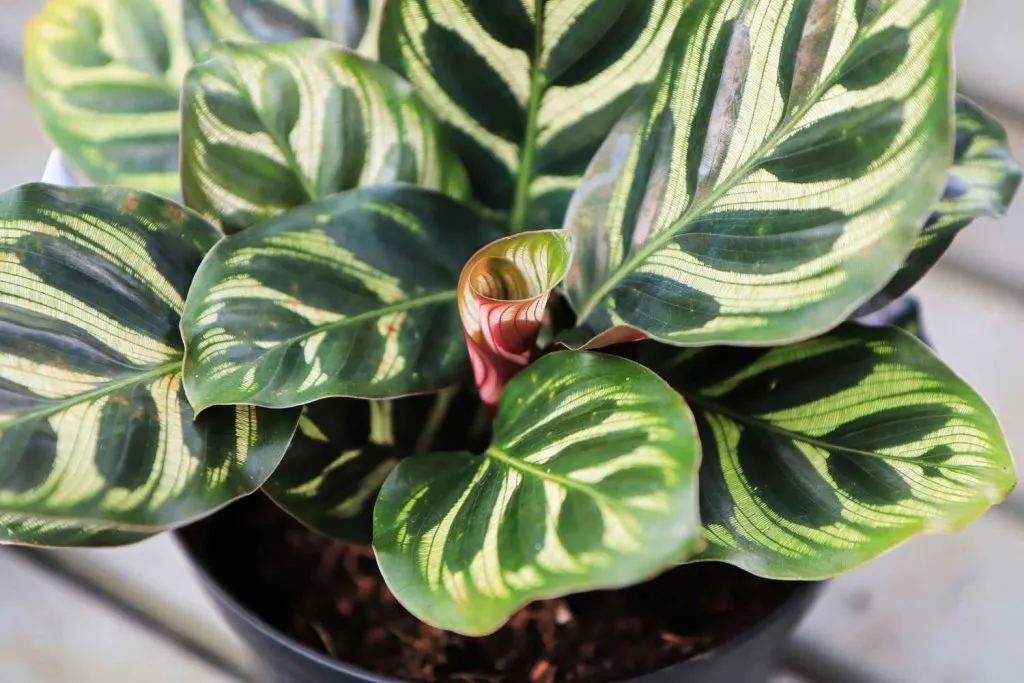
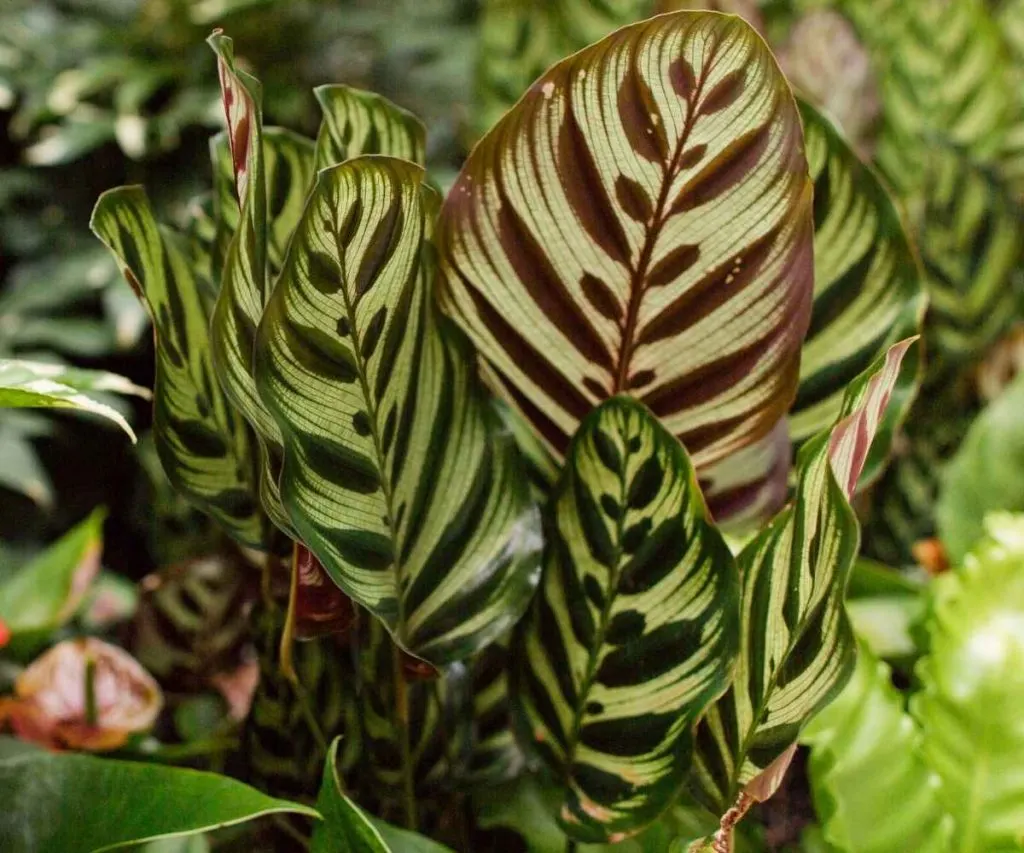
The Makoyana is often confused with the Roseoptica Calatheas. The leaf pattern is similar. Notice the pink color of the striping on the underside of the leaf. Lots of visual interest with this plant.
The calathea makoyana peacock plant is also Known as Cathedral Windows due to its stunning leaf transparency. Light glows through the leaves and shows off the pattern with delightful iridescence. Like a beautiful stained glass window.
See the leaf detail below. Notice the backlit leaf on the right is translucent when the light shows through the shiny leaves.
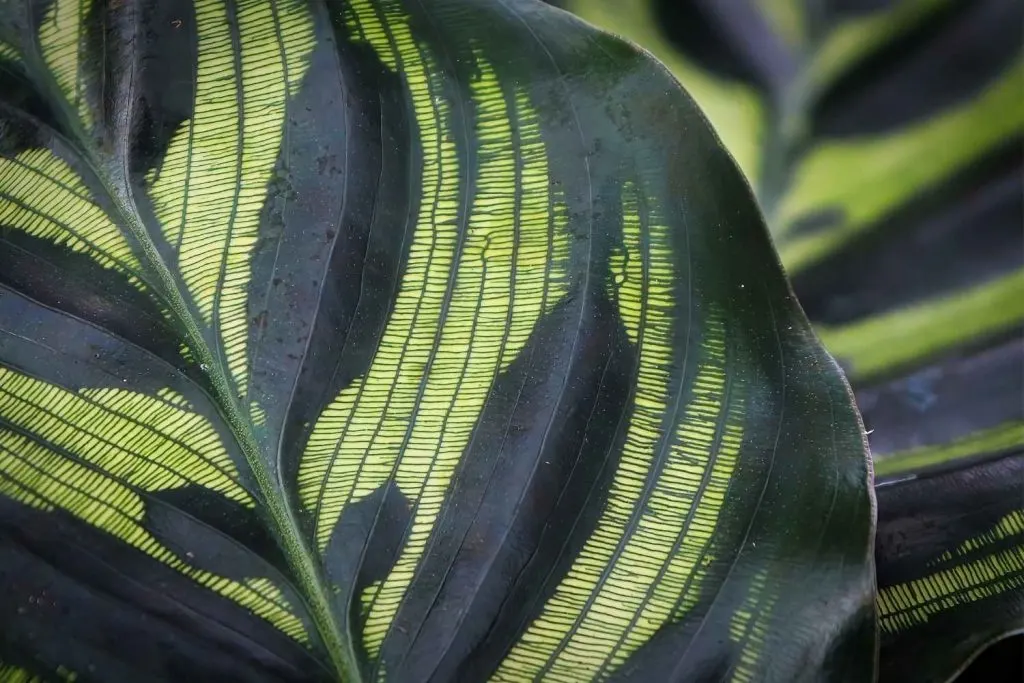
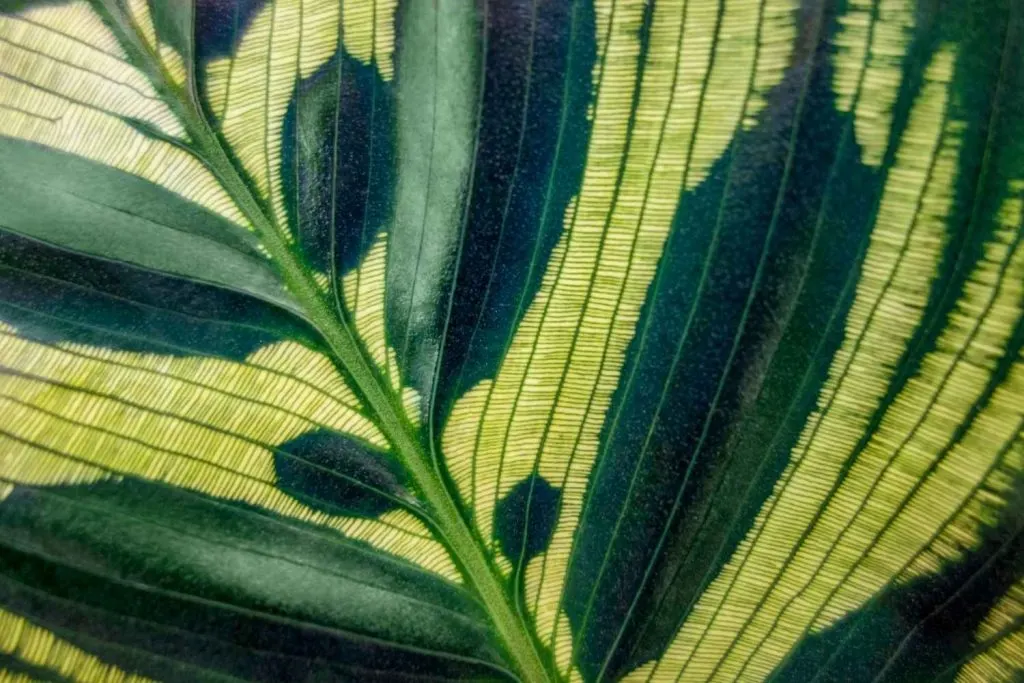
The Makoyana has a patterning reminiscent of Calathea Musaica with its tight network of outlined cells resembling netting.
Calathea Peacocks Are Tough!
Your challenge is to recreate tropical rainforest climate conditions so your Makayana is satisfied. Picky Calatheas won’t be ignored. Give them what they want or they will complain with poor foliage, then wither … and eventually die.
The good news: Calatheas for all their fussiness are really rather tough. And this princess plant is reasonable in its own way. Keep the conditions steady on and favorable. It will grow beautifully for you.
My pinstripe ornata was my teacher. It went from healthy foliage to a bare stem in the ground. I researched like mad. I finally gave it what it wanted. It is now growing new healthy top growth.
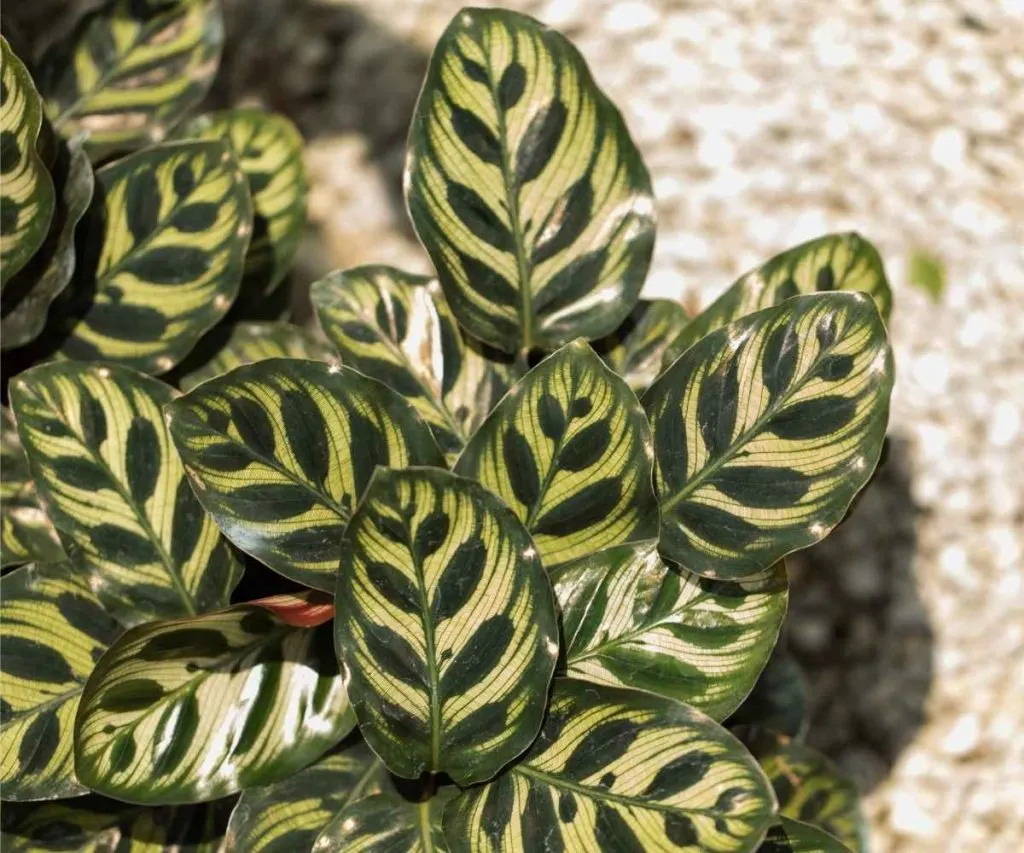
If you have a failing Makoyana don’t despair. Learn what it needs and do that. It very well may come back from the dead.
Purchase Calathea Makoyana on Etsy
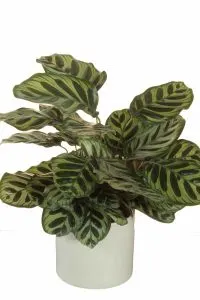
Nurturing your Peacock Plant:
I suggest two inexpensive and helpful plant tools to assist you with calathea makoyana care A moisture meter and a hygrometer.
The moisture meter is VITAL to someone, like me, who loves to water plants. It will keep you accountable.
The Contented Plant
Do NOT water a wet calathea. This weakens the plant and invites diseases and pathogens into the soil. They will also get root rot, fungus gnats and pests.
Makoyanas love evenly moist soil that occasionally almost dries out. But they cannot be completely dry. Or the leaves will crisp on the edges.
Take the guess work out of it with a moisture meter like this one for about ten dollars.
Humidity is another climate condition that is vital to your Makoyana peacock plant.

This may seem like a lot of fooling around to keep a plant happy. It is. This is not a beginner plant. The care is fairly simple but they do require monitoring and adjusting conditions to keep them happy.
Good thing they are so very pretty!
Nurturing is good for us. Calathea Makoyana requires you to be a successful nurturer. But it gives you something in return.
Calathea Makoyana care needs are the same as other prayer plants. Learn best practices for the care of the Peacock plant. Enjoy the graceful beauty of this plant.
Calathea Makoyana Care guide
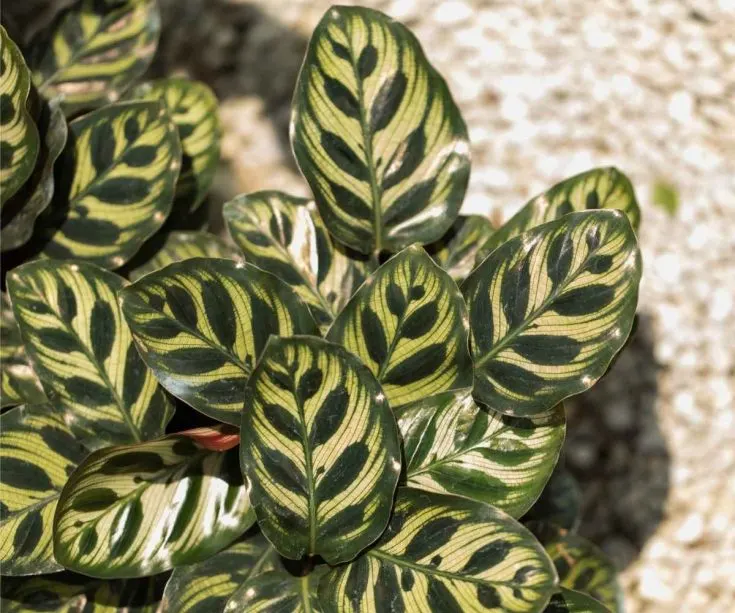
Calatheas Makoyana is a beautiful, exotic plant. Their care needs are specific and important. They are sensitive. This is Not a forgiving plant.
Once you find the perfect growing conditions for your calathea Makoyana Peacock it will perform well for you.
Learn what they need and give it to them. Their lovely foliage is so worth the effort!
All Calathea plant care is similar. No matter what type you own this care guide will apply.
Materials
Tools
Instructions
Soil Preference:
- Calatheas enjoy a light well draining soil.
- A mix of potting soil and perlite and peat. Coir will keep the roots happy if well mixed with lighter soils.
- Our mix for this plant is 30 % potting mix, 30% succulent soil or coir and 30% perlite or pumas.
- A heavy soil potting mix is not recommended for these plants.
Pot Size and Type: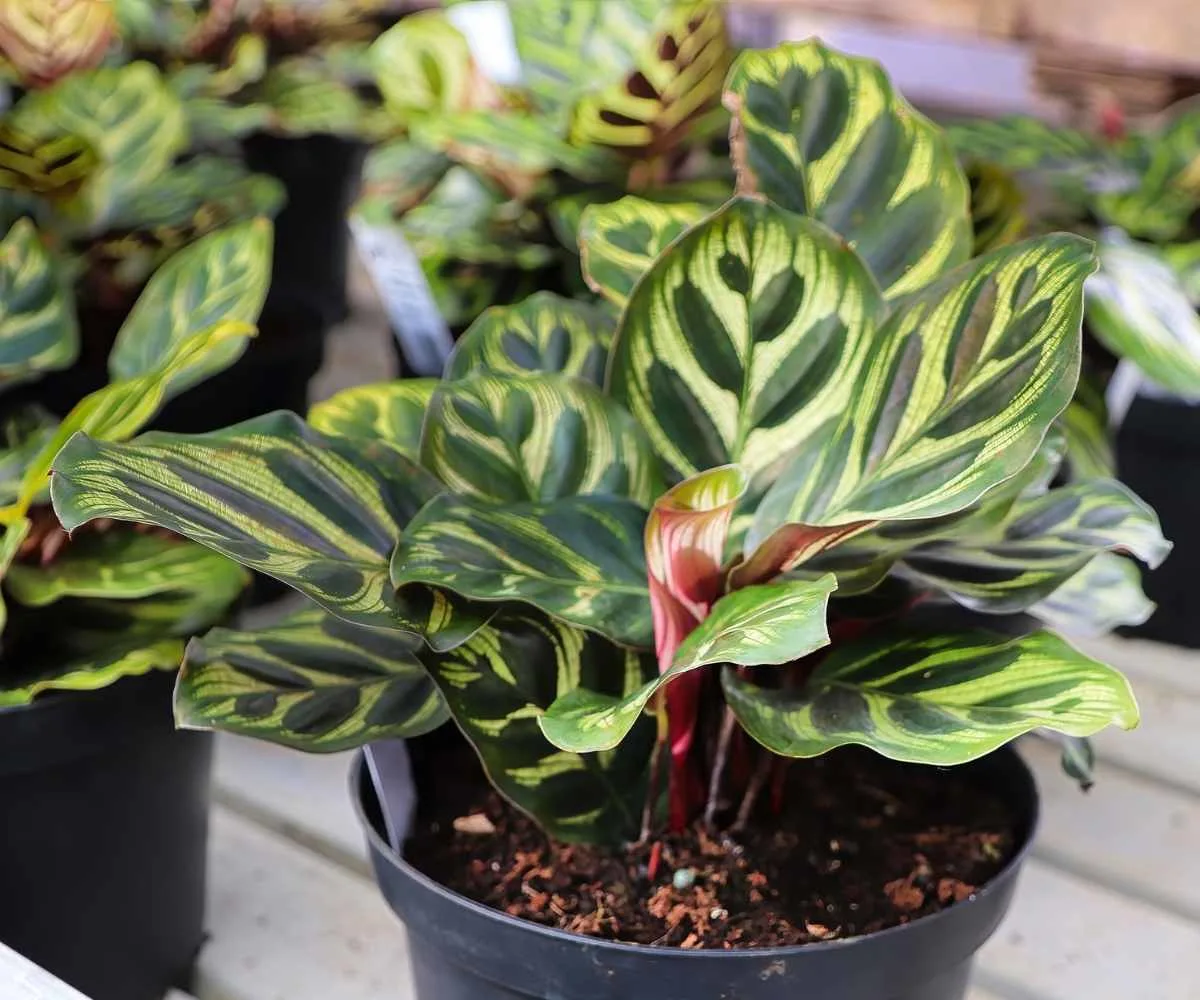
- Calatheas grow from rhizomes. And they grow new offshoots to the sides of the mother plant.
- This means they will fill a pot out as a wider plant eventually. Quite a nice table top centerpiece.
- Calathea Makoyana will grow to the size of the pot with one or more rhizomes. If you leave it to grow as a grouping of rhizomes in one pot you will need to find a pot that has a wider circumference. They do not like to be overly root bound.
- If you want to encourage faster growth choose a pot about 2 inches wider in diameter than the current pot.
- Use a well drained ceramic or plastic pot. It MUST have excellent drainage.
- Terra cotta pots are not recommended. They will wick too much water away from the soil.
- Repot every second year or when roots come out the drainage holes on the pot bottom To the next pot size up.
- Don't jump to a huge pot from a small one unless you wish to encourage faster growth. Just go to the next size up pot. A Too large pot with too much constantly moist soil will encourage root rot.
- For Calatheas a self watering pot system work well. (linked above). They control the watering for you and help avoid root rot, overwatering and under watering.
Lighting: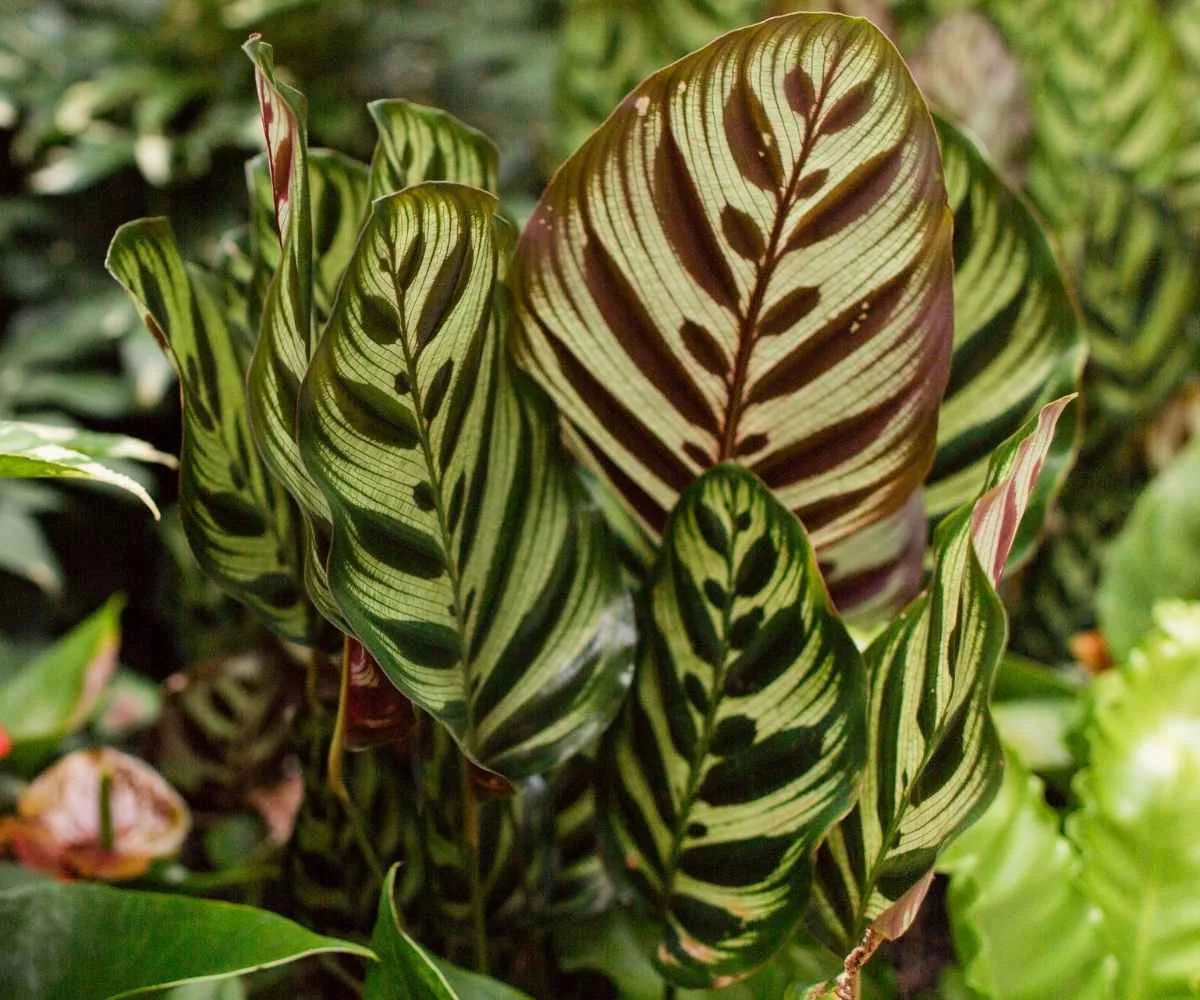
- Calatheas enjoys indirect light for best leaf variegation and optimal growth.
- If the leaves fade move to a less bright area and see if that helps. Too much light can also fade the leaves and crisp the leaf edge.
- It will tolerate lower indirect light but the plant may grow more slowly. Leaf variegations may not be well expressed.
- Shield the plant from strong direct light in summer south and west sunny windows. The leaves will burn and the colors will fade. Look for dry brown spots on the leaves and curling brown edges. If you see them move the plant to lower light.
- Tip: Window sheers or blinds can offset some brief periods of high direct light.
Watering:
- Your Calathea Makoyana is VERY sensitive to the water you use. These plants love low mineral, soft acid water between 5.5 and 6 Ph. Hard water high in minerals and salts will burn the leaves.
- Collect rain water or use Filtered or distilled water to prevent problems with minerals and PH.
- Water your Calathea Makoyana Peacock plant when the soil is dry down an inch or so. Calatheas enjoy even moisture in the soil. But never let it sit in soaking wet potting mix.
- Be sure to use your moisture meter every couple of days and especially before watering. The dial should read moist when pushed down to the bottom of the root system. If the meter reads dry you need to water. But if it reads wet WAIT. This is important. Calatheas are sensitive to root rot. Do not overwater!
- Calatheas enjoy evenly moist soil. However, don't water your peacock plant until your moisture meter tells you the plant is verging on dry in several places in the soil.
Watering Problems:
- If your calathea leaves start to roll up and curl, the plant droops or the edges turn brown suspect watering problems.
- Under watering can show all the symptoms listed above and most often causes leaf edges rolling up, brown tips and crisping. Adjust your watering or soil mix to accommodate.
- Over watering will end in root rot, grey mold on the leaves, algae growth on the soil and fungus gnats or other pests moving in. Yellowing leaves can also mean the plant roots are too saturated and are starting to die.
- For best practices Try a watering schedule of once a week. But do not water if the soil is wet. Alternately, Do not let the soil dry out completely.
- Watering is best done on a regular schedule with a moisture meter check so the plant is not over or under watered. Both can cause stress.
- These tropical plants enjoy humidity of 40 to 60%. Use a hygrometer next to your calathea to make sure you have enough humidity for them.
- Never let this plant get wet feet. If the soil is compacted the bottom of the soil can remain wet which encourages, grey mold on the leaves, root rot and Fungus Gnats. If you see yellow leaves or leaf tips you are probably overwatering or Inconsistently watering.
- In dormant winter months reduce watering to when the soil is dry down 2 inches .
Humidity Tips:
- Calatheas are happy at 40 to 60% humidity. Although they can tolerate higher, do not let it drop under 40%.
- I use an inexpensive hygrometer to monitor the room temperature and humidity levels near mine. It is cheap and so helpful!
- In dry climates this plant will thrive with a humidifier nearby. Or set it in your kitchen or bathroom.
- Frequent misting on a regular daily schedule will help.
- Set the Calathea plant on a pebble tray with water not touching the pot bottom for added humidity as necessary.
- Grouping plants together will also provide more humid conditions as they respire and evaporate.
How to Fertilize: 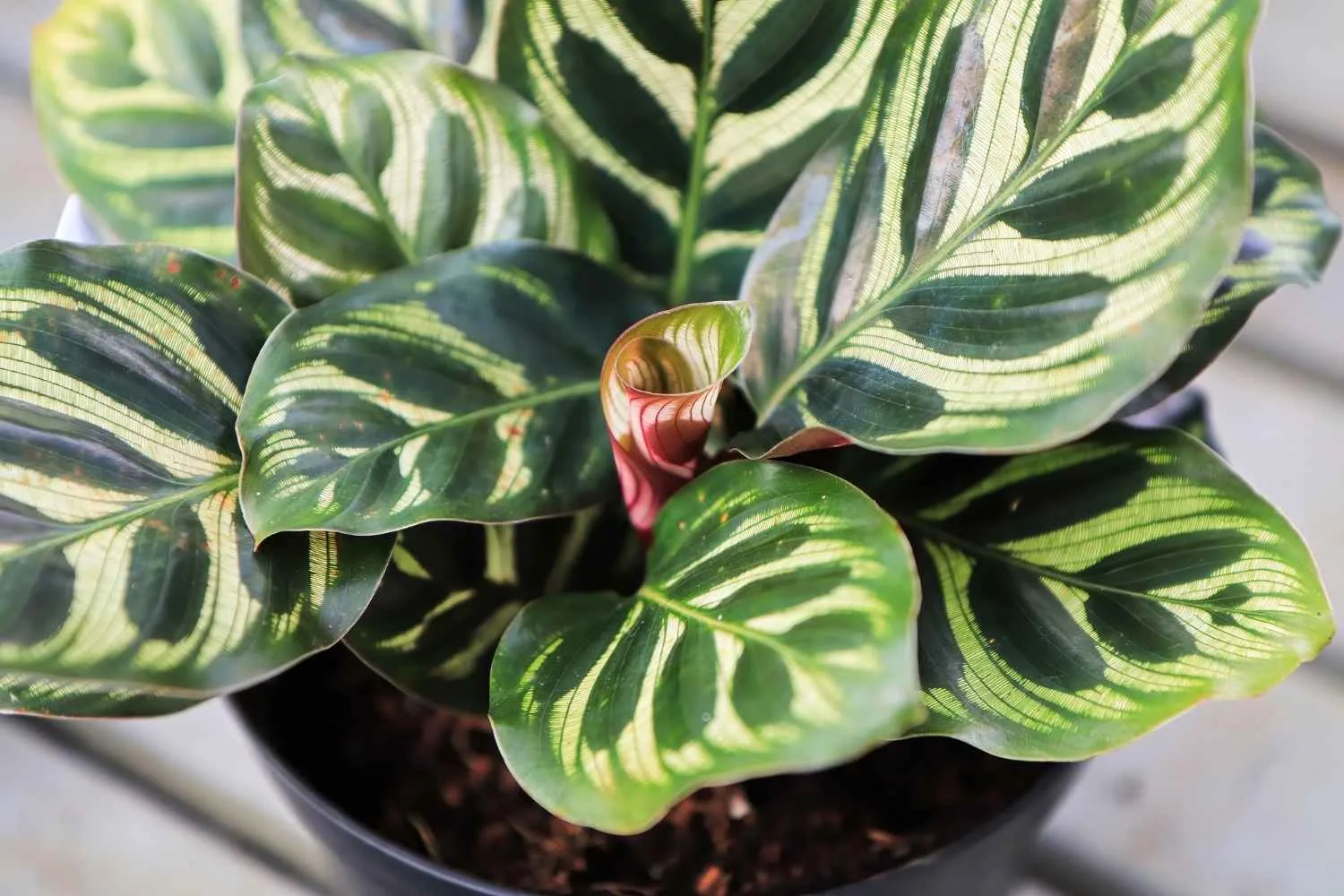
- Calatheas require a regular fertilizing schedule. BUT, they are susceptible to fertilizer burn.
- Apply a good quality fertilizer (linked in materials) monthly through Spring and summer at half dose. If you see burn marks on the plant leaves reduce fertilizer by half again.
- Decrease feedings by late Fall and allow your Calathea plant to rest through the winter months.
- Look for brown spots on the leaves of your plants. This may indicate an over concentration of salts in the roots from over feeding. It can burn the leaves.
- The remedy is to set the plant under a faucet of water and let the water run through for 10 minutes or so. Allow the pot to Completely drain. Discontinue fertilizer until the plant recovers.
Temperature:
- Optimal temperatures for Calathea Makoyana are 65 degrees F. to 75 degrees F.
- Calatheas are sensitive to cold drafts from windows and doors.
- In winter, beware heat vents blowing on your plant leaves. Calatheas cannot tolerate uneven heating, or drying heat vents or drafts.
Pruning and Training:
- Sharp sterile Hand pruners or sharp scissors are preferred for pruning. They will give a clean cut that will heal quickly.
- Pruning is usually done to shape the plant or cut off unsightly leaves.
- Calatheas grow wider rather than taller with time. The Peacock plant grows to about 24 inches high. This makes them good choices for desk and table top plants. Or set them in a deep, indirectly lit window sill.
Leaf Care: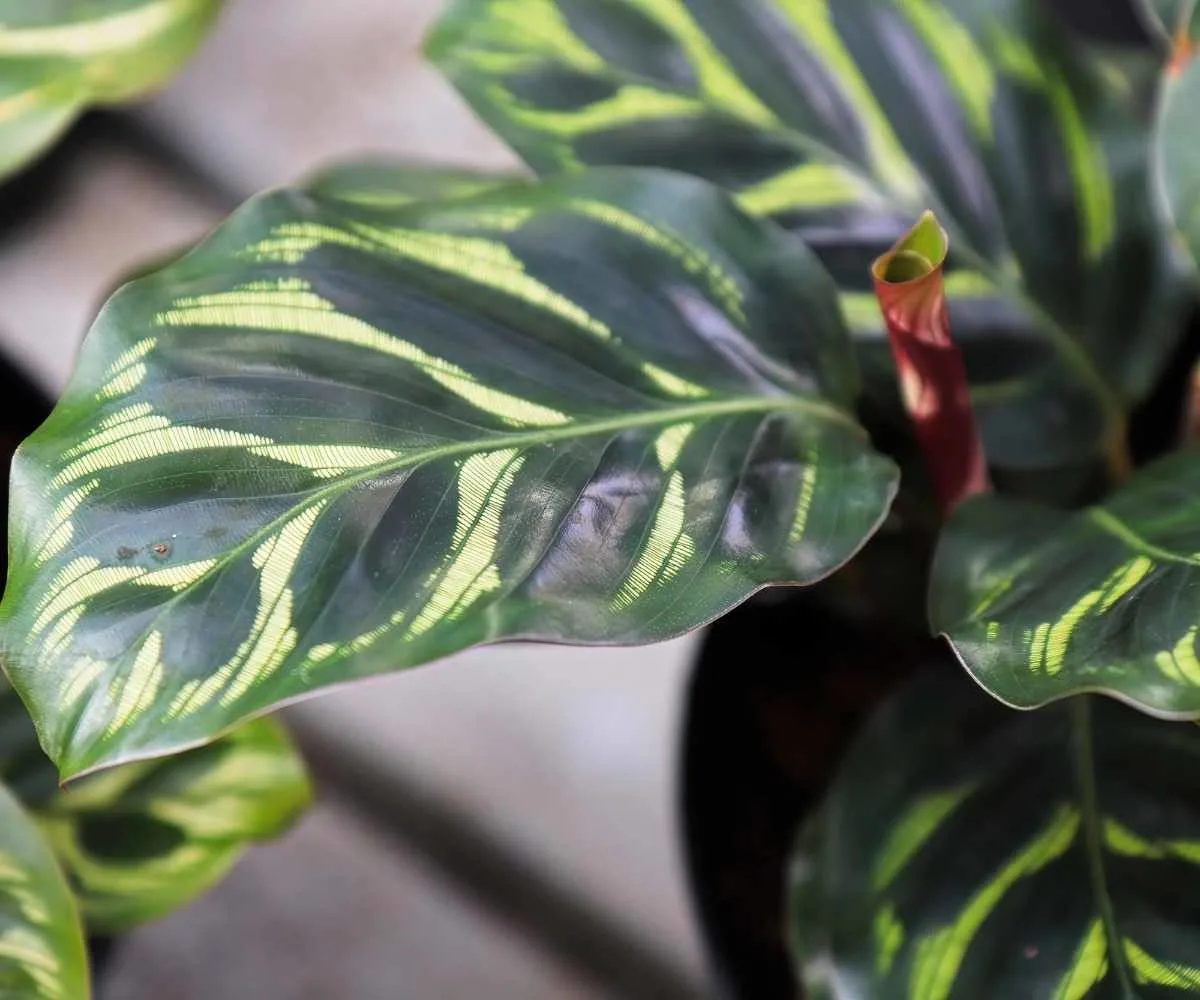
- For the best care your makoyana plant leaves enjoy occasional washing.
- This helps keep the stomata (leaf pores) open for plant respiration.
- Healthy leaves with a good clean surface are most able to resist pests. Neem oil leaf shine and water is a good choice for leaf washing.
- Dusty leaves will starve the plants of water exchange through humidity.
- Hand Wash the leaves monthly with water and neem oil.
- You can also use a shower to clean off a calathea. Beware the water temperature. Keep it room temperature to avoid shocking the plant.
Pests:
- All plants get attacked by pests. Calatheas are especially susceptible to spider mites.
- Stress by longterm poor watering practices, poor light, extreme temperatures and soil conditions are contributors to pests. Fungus gnats will set up house in the soggy soil of an overwatered plant.
- Washing the plant leaves occasionally with neem oil leaf shine will help keep pests from establishing themselves on the plant.
- Spider mites are the biggest problem for Calathea plants. Watch for the webs. Treat immediately and continue for two weeks or more to remove the next generation of spider mites after the adults die. Eggs attach to the leaves and cannot be washed off easily.
- Mealy bugs, scale, thrips and whitefly are also common houseplant pests you will see in a stressed Calathea.
- Read our post on How to get rid of aphids and other pests with our homemade pesticide soap recipe or neems oil.
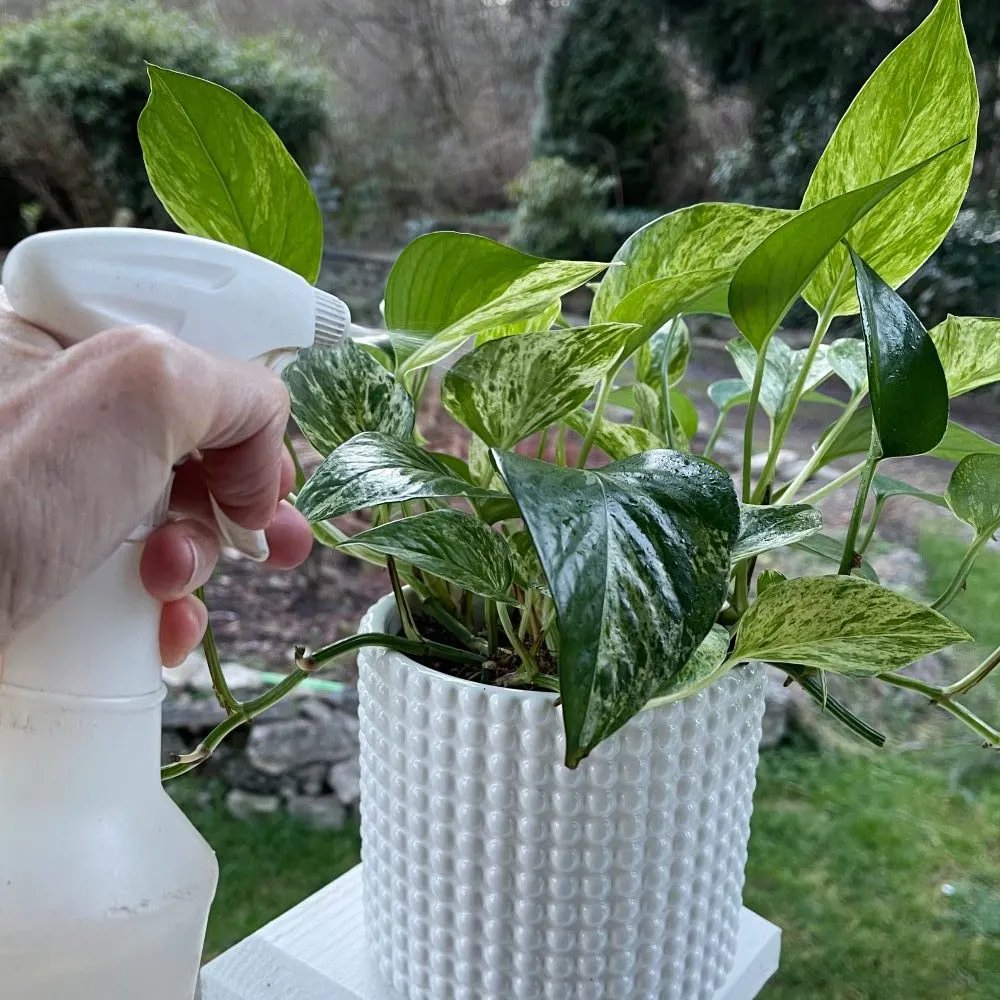
- To minimize the possibility of pests be sure to check all nursery plants before bringing them home. Carefully examine the top and bottom of the leaves.
- Do NOT purchase plants with signs of pest damage or disease.
- Quarantine all new plants until you are sure no pests live in them.
How to Propagate Calatheas:
- Propagation is best done through root division.
- Seed propagation can be done but the seeds can be difficult to source.
- Dividing a calathea is easiest when repotting it in spring or summer.
- Unpot the plant gently. Look at the root system. If the plant is mature you should see a natural parting in the leaves and roots. This is the two plants growing together.
- Each plant section will have its own rhizome. This is going to look like the stem growing straight down with roots coming off them.
- Gently pull apart the two rhizomes to separate them. If the roots are heavily intertwined cut them as necessary with sharp sterile scissors or small pruners.
Pot the two plant sections in separate pots. In 2 to 4 weeks the divisions should be settled and growing.
Non Toxic Plant:
- All calatheas are non toxic to humans and pets. Still it is not recommended to chew any houseplant.
- Biting or swatting are not good for the health of the plant.
- Also you don't know what chemicals, pests or pathogens are in the soil or fertilizers you use. So best practice is to keep houseplants away from pets and kids.
Notes
The video below is relevant to the care of all calatheas:
More Calatheas To Love:
There are SO many Calathea varieties. They make wonderful houseplants. ALL calatheas are non toxic to humans and pets. And Calatheas purify the air around them. They all have very similar care needs. Make a collection!
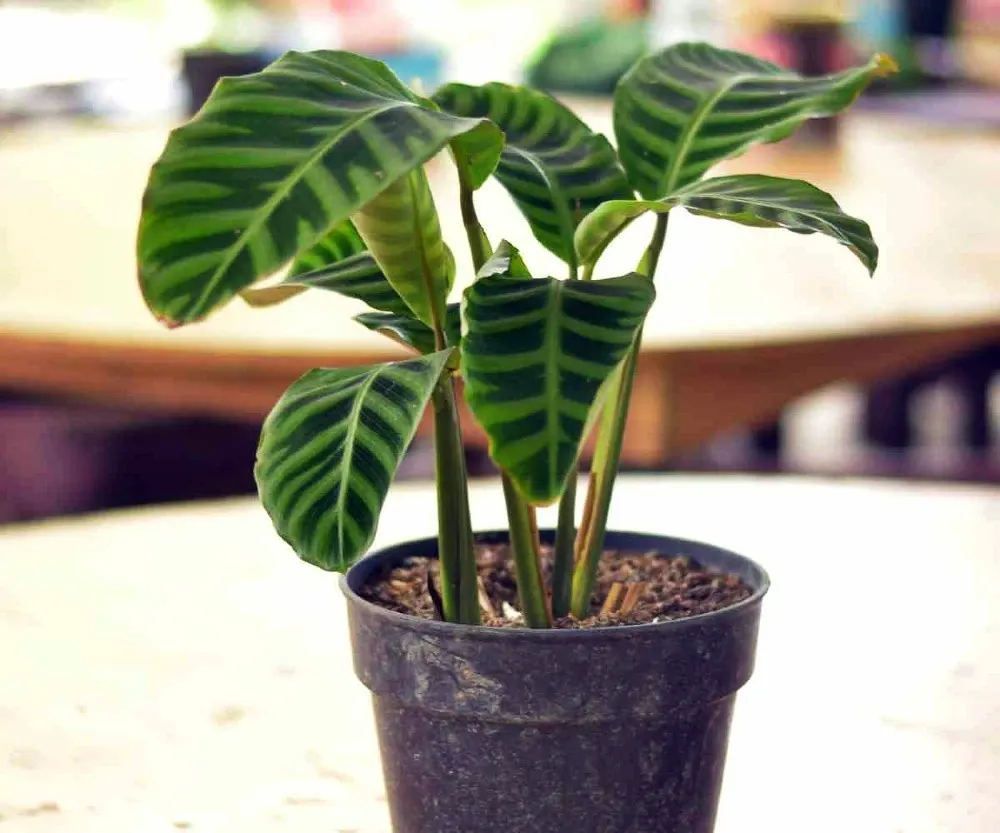
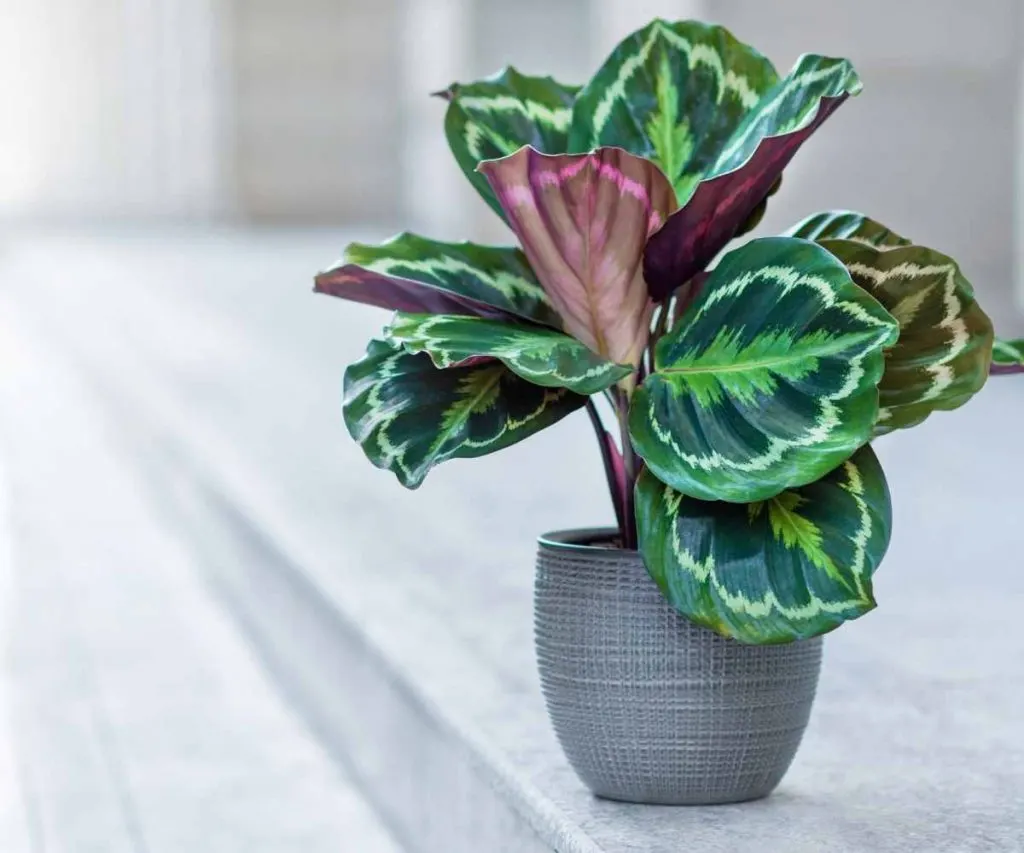
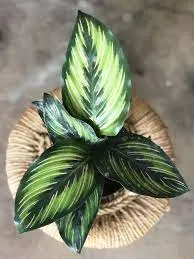
Follow Us:
Find us on YouTube, Instagram , Pinterest and TikTok! We love to Plant chat. We also comment, like and occasionally share your content to our daily stories. We’d love to see your plants. Share your joy in your houseplants. Happy Planting!
Recent Posts:
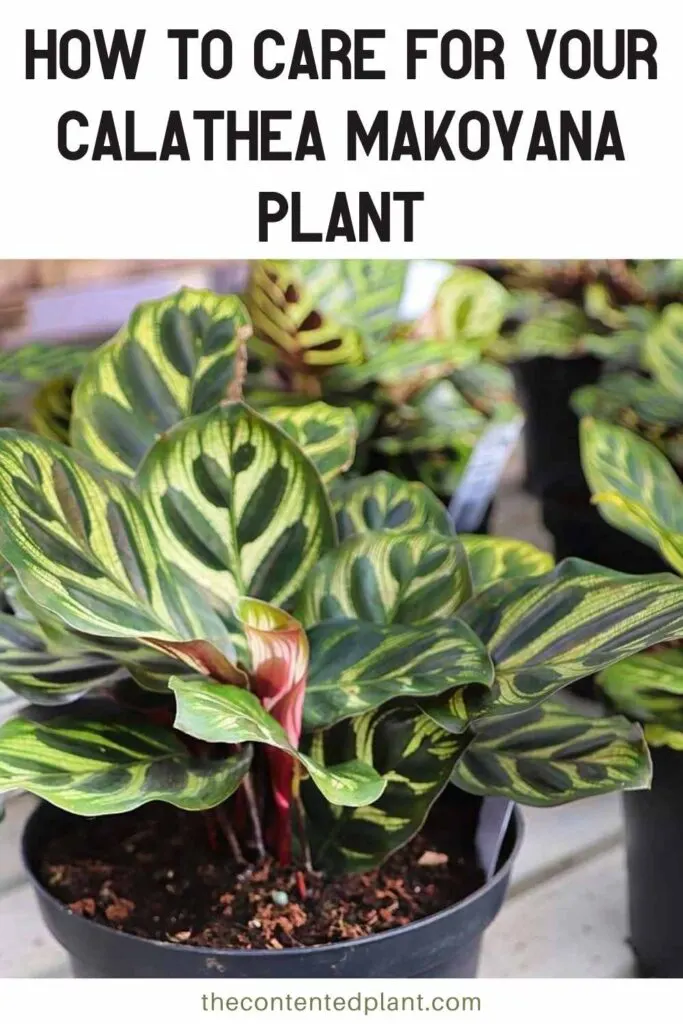


Growing Plants in LECA - The Contented Plant
Monday 1st of August 2022
[…] boil LECA for my more sensitive plants like Calatheas even when it’s newly purchased. Boiling ensures NOTHING is in there that can bother […]